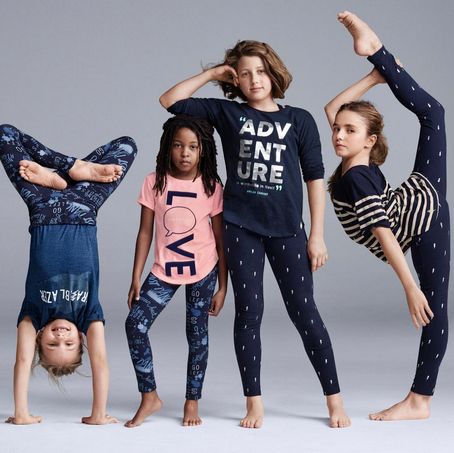On Sunday, Gap Kids drew the ire of Black Twitter after the release of their latest ad campaign, featuring Ellen DeGeneres and members of the pre-teen dance group Le Petit Cirque. In the video component of the ad the four girls, ranging from ages 8 to 12, talked about their humanitarian work, why they love being part of the troupe, and girl power.
The ad was meant to be cute and empowering while selling Gap's new line of athletic kid's clothes, but many people took issue with the fact that the only black girl featured in the ad, in one photo, is essentially used as an "armrest" by her older, taller troupe member:

While the three other white girls in the photo were striking powerful, strong poses, some people complained that the black girl appeared passive, more of a "prop" and a token than anything else. In the video component of the ad, too, she seemed detached and largely silent, while her white group members did most of the talking.
"It becomes problematic when the black child is positioned to be a white child’s prop," explained Kirsten West Savali of The Root, in the wake of the controversy.
Though the ad has drawn criticism from many black people who find it to be yet another offensive example of the ways in which black women and girls are belittled, undermined, and dehumanized in the media, others have argued that the reaction to the ad is a wild over-exaggeration.
Filmmaker Matthew A. Cherry played the part of devil's advocate on Twitter, where he posted the Gap Kids ad and a similar ad featuring a black girl resting her arm on the head of a shorter white girl. "Does the @GapKids pic on the left make the pic on the right okay? Let's debate," Cherry tweeted.
It would be far too easy to say that the picture on the left, from a 2015 Gap Kids campaign, makes the new ad okay. And it would be far too easy to simply call the picture on the right flat out racist, without fully unpacking what that means.
In cases such as these, cases when something clearly well-meaning brings up passionate criticism and accusations of racism, there's always the suggestion that black people need to "pick and choose" our battles. Why complain about a harmless ad when there are black people being shot and killed in the streets? Why alienate people from caring about black issues by crying racism over every real or imagined racial slight?
But it's tricky. It is, perhaps, far too simplistic to simply call this ad racist. Upon seeing the ad and the reaction to it, I (as a writer who relishes in calling out racist BS), raised an eyebrow at how worked up people were over it. My initial reaction was not "this is racist!", but that it was certainly a bad PR move.
I found the pose to be pretty harmless. And yet, it's unfair to say that the people who do take issue with the photo are simply overreacting. Because it's not the pose itself that is the problem, but the context in which it is delivered. The context being: an advertisement, with all the conscious or unconscious messaging that images used to sell an idea tend to entail. In this case, that messaging is construed by many as a black girl being inferior to her white counterparts. It's a shame that these four little girls have been caught in the crosshairs of this heated debate, but the fact that so many people have protested the ad speaks to a reality that cannot be ignored.
The reality is that there are so few positive, powerful representations of black women and especially black girls out there that, frankly, it's unsurprising that the photo would touch a nerve. That nerve, really, is where we should focus. That sensitivity, no matter how "over the top" it may seem to those who don't get it, is still valid. It comes from a real place. It comes from a place that so many of the (mostly white) decision makers in the world of media are oblivious to. Perhaps if there were more black people and other people of color in positions of power in media and advertising, controversies like this one could be avoided.
Now, what are we going to do about that?
